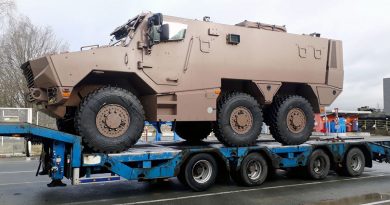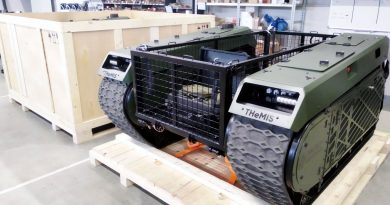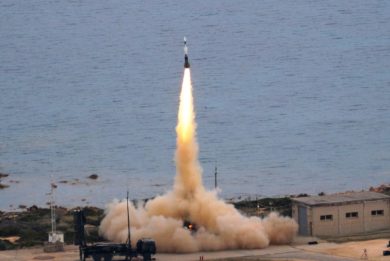Thales will upgrade the Royal Netherlands Army TACTIS vehicle simulator training centre to answer the needs of new vehicles and scenarios
Ensuring realistic training for armoured formations has become increasingly difficult, due to the limited space available, environmental constraints and costs. Simulation is gaining importance, as it often allows an even better training compared to actual training in the field, and it also permits testing new tactics. The Royal Netherlands Army has been one of the most active in Europe in terms of simulation, and is now moving to a wholly new level of simulation with the contract announced in late April with Thales, the company being ready to completely overhaul the TACTIS simulation system that was built nearly 20 years ago
In the second half of the years 2000 the Royal Netherlands Army inaugurated TACTIS, the TACTical Indoor Simulator, part of the Land Training Centre (LTC) and Land Warfare Centre in Amersfoort, 20 km south-east of Amsterdam. The centre, who gave the contract to Thales, was to be used to train armoured and mechanised formations. A new building was built to host the simulators as well as classrooms and support systems. The TACTIS centre hosts 15 high fidelity Leopard 2A6 main battle tank (MBT) simulators and 14 low fidelity YPR-765 infantry fighting vehicle (IFV) simulators; the suite was completed with eight supporting general simulators took care of the deployment of artillery and engineering forces, two artillery observer simulators and 16 simulators for dismounted troops. In 2008 an amendment to the initial contract was signed, to add the simulator of a new vehicle to the existing ones, that of the CV9035NL, the new IFV that was being acquired by the Koninklijke Landmacht. Five fixed and eight mobile simulators were therefore added to the system. Mobile assets are truck-based and can be deployed anywhere, usually used in sets of four simulators and one after action review room, the same number of mobile assets being available within the 15 MBT simulators. When located at the Bernhardkazerne in Amersfoort the mobile simulators are fully connected with the overall TACTIS simulation system, while when they are deployed, they form a stand-alone cluster.
All fixed simulators are installed in a 2,450 m2 hall, while mobile simulators are hosted in a storage area at the lower level. The main lecture hall, which is usually exploited for debriefings, can host up to 150 people, four smaller classrooms being also available.
After nearly 20 years it was time to renovate TACTIS, as new and more sophisticated vehicles are due to enter service with the Royal Netherlands Army, mainly the CV90 MkIV and the Leopard 2A8. Moreover, simulation technology has considerably evolved, and new systems are able to provide much more realistic scenarios to the trainees. “We will be integrating a whole series of new technologies to create ultra-realistic environments, for example using graphics engine technologies like Unreal Engine 5. This will allow the Dutch forces Land Training Centre to be and remain for decades to come, the largest and more modern European armoured vehicles training centre,” Benoit Broudy, Vice-President for Training and Simulation at Thales, told EDR On-Line.
The Amersfoort simulation facility is not only used by Dutch soldiers, also German, Norwegian, Danish and Estonian military benefit from it, these nations having in service Leopard 2s and/or CV90s.
The next-generation training centre, as it was dubbed by Thales representatives, will incorporate more than 76 interconnected simulators, will be able to connect 200 people, human beings or trained crew members, and to mix them with more than 2,500 virtual combatants, usually defined “Computed Generated Forces” that may operate both as friendly forces or as opposing forces (OPFOR). “We will add new capabilities, such as the capacity to disembark and control dismounted 3D infantry soldiers controlled by the trainees during the simulation, who will deploy, interact with the environment, and join the fight. In addition to the high-level simulators for MBTs and IFVs, some vehicles will have a more generic simulation that will provide a lesser fidelity.
Beside the aforementioned heavy armour, other simulators will populate the LTC, among them those for Boxers and Fenneks, the latter reconnaissance vehicle also undergoing an upgrade programme. Logistic vehicles will also be part of TACTIS, overall, more than 20 types of vehicles being represented.
To populate the scenario virtual land and air assets will be available, through a wide database allowing to simulate both western and eastern systems, such as MBTs, IFVs, artillery systems, UAVs, attack helicopters and so on. EDR On-Line understood that OPFOR will be shaped to play according to enemy doctrines and tactics, while TACTIS will allow Dutch formations to test new tactics.
The TACTIS upgrade will be conducted in phases; “Today the demand for training exceeds availability, which explains that phased approach, as training cannot be interrupted,” Benoit Broudy explained. The mix of vehicles will remain very similar to the current one, Thales being already working with BAE Systems Hägglunds in order to ensure maximum realism and is ready to do the same with other OEMs. “Thales and BAE Systems Hägglunds have partnered for the modernization of TACTIS to bring this simulator to reflect the latest configuration of the CV9035NL currently undergoing Midlife Upgrade in the Netherlands, but also to enable future capability growth in the simulator as the CV90 platform evolves,” Ola Berg, Regional Manager at BAE Systems Hägglunds told EDR On-Line. “The teams are working closely together in order to deliver the optimal experience and realistic training capability to the end-user in a timely manner, this reduces costs and increase efficiency for the user. We are looking forward to partnering with Thales for the next decades supporting the Royal Netherlands Army with this key asset in their training portfolio,” he added.
The decision to acquire 46 Leopard 2A8 was announced on April 16 by the Dutch and German defence ministers. These MBTs will allow the Royal Netherlands Army to field again a tank battalion, no such unit being part of the service since the decision to sell all its tanks following the end of the Cold War. The new tank unit to be stationed in Germany, in Bergen Hohne. As soon as the contract will be signed, Thales will start working on the agreement with the OEM producing the MBT. Due to its open and scalable architecture, TACTIS will be able to integrate simulation of the Leopard 2A8.
As said, the modernized TACTIS training centre will be much more advanced than the current system, and will include AI-based algorithms, EDR On-Line understood, that will help especially in managing virtual combatants, either individuals or vehicles. Over 30 different types of terrain are saved into the system, “simulation getting to the point that leaves are moving according to the wind,” the Thales VP for Training and Simulation told us. All sensors installed on vehicles have to provide the most realistic vision as possible, communications and networking between vehicles and soldiers being also considered. The more realistic the scenario, the bigger the computing capacity and the data throughput needed to support the system. Although no data were provided, it is clear that Thales incorporated new computing frontiers to cope with current TACTIS capabilities, and to leave a growth margin for future enhancements.
Thales considers training and simulation a potentially growing market. “What we are seeing is a growing interest from all armed forces for various reasons,” Benoit Broudy explains. The first one is the quality and relevance of simulated training, the second being the cost; compared to training with real vehicles, a simulated one is 50 to 100 times cheaper. Third comes the fact that nowadays armed forces prefer saving ammunition and vehicle potential for real case use, should this be needed. The possibility to test new tactics and doctrines as well as new scenarios comes fourth, TACTIS allowing to go up to Level 4 training, which means combined arms training at company tactical group level. Last but not least comes the environmental aspect.
One aspect concerning the importance of mobile systems is surfacing thanks to lessons learned in Ukraine. EDR On-Line understood that training centres are considered key targets by the enemy, therefore being able to disperse training assets allows to increase their survivability. Of course, being made of a reduced number of simulators, usually four, the mobile training centre will be capable to provide Level 3 training, platoon level, and not Level 4, however it will be able to provide this at the unit location, both in peaceful situations as well as in wartime. It might even be used to carry out rehearsals before an actual action, eventually testing different tactics while simulating different enemy behaviours.
Photo courtesy Thales, Netherlands MoD and P. Valpolini








